
Swaddled baby [lower-alpha 1] votives are figures of babies offered as an entreaty to a god or goddess, [lower-alpha 2] for healthy pregnancy and childbirth. They have been recovered from ancient Italian Roman temple sanctuary sites.

Swaddled baby [lower-alpha 1] votives are figures of babies offered as an entreaty to a god or goddess, [lower-alpha 2] for healthy pregnancy and childbirth. They have been recovered from ancient Italian Roman temple sanctuary sites.
In ancient Rome, family was important to create new citizens and widen political dimensions. [2] The newborn Roman these votives represent had faced an uphill battle to make it through to this milestone. It is common in Roman antiquity for women to experience high infertility and mortality (1 in 50). [3] Women married young, and it was expected of them that they would procreate successfully early into the marriage and often. Many things could go wrong and affected her fertility in this endeavor and her ability to survive the pregnancy. [4]
Newborns as well experienced a high mortality rate (up to 35%) for a myriad of reasons. [4] In fact, there was the possibility that the pater familias (legal head of the family) legally might deem them unworthy of life. It is common in circumstances of high infant mortality to refrain from bonding with or naming an infant. [4] When the Roman child was 8 (for female) or 9 (for males) days old there was a Dies Lustricus (day of purification) ceremony whereupon they were officially named and entered society as a full-fledged Roman citizen. [4] Within 30 days the legitimate citizen child had to be registered in a declaration (professio) before a magistrate. [4] The register of births displayed temporarily in public and the permanent copy in the official state archives are further indications that an infant had a social and public persona. [4]
After birth, a period of 40 days is described as critical and marked by various events and rights in the Roman world. [5] The newborn baby gradually adjusted to its surroundings. After the forty day milestone was reached, the baby was released from the swaddling bands in which it had been wrapped since birth. [5] As such, it is thought that Roman swaddled baby votives must represent infants during the first 40 days of life. This would be when the votive would be offered. [6] The unwrapping of the swaddling clothes represented a stronger, healthier child. [1]
Votives are gifts to gods by worshippers. In this instance they are given to gods in gratitude for the fulfillment of the vow to the god for divine favor. Unlike anatomical votives which are made to resemble a body part, the swaddled baby votive is assumed to represent the child's body in its entirety. [1] For example, at the temple of Mater Matuta in Satricum, archaeologists discovered votive models of wombs, figurines of women with children, and terracotta swaddled infants. [2]
Due to high infant mortality rates and complications with infertility, either parent could offer vows to deities in the hopes for successful pregnancies and the survival of the child. Sometimes described as an Ex voto, their dedication and deposition can be understood to be thank offerings for the fulfillment of oaths to a deity for health expressing the reciprocal relationship between gods and humans. [2] This religious offering dates to the 5th century BCE, heightened during the third century, before it declined significantly during the second century BCE. [7]
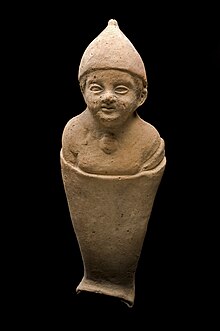
The swaddled baby votives of ancient Italy were predominantly fabricated from terracotta but have been recorded also in metal (bronze, gold, silver) and tufa. [7] [2] They can range in size from fitting in the palm of your hand to life-sized. These swaddled human representations were seemingly modeled to lay down, lean, or hang as they are created flat on the back. [8]
The votives featured a healthy cherubic face for the most part and the styling of the swaddle banding is geometrical. The way the simulated child is wrapped varies in detail. Some, evidentially male, feature bulla (amulets), [4] some have exposed toes, and some wear hats. These features reveal details about social status, locale, time period or even the choices of the individual craftsman. There is a distinct lack of epigraphic evidence for decisive definition. [1]
Swaddled baby votives, have been found in regions including but not exclusively Etruria, Latium, Campania. [7] It is problematic to determine details about their placement within the temple as they are, with few exceptions, discovered in sanctuary pits. [5] The votive was placed and left for a period of time within the temple, the ultimately when space was needed the accumulating votives would be removed and relocated to their ultimate destination on the sanctuary grounds. [2]
In ancient Roman religion, Lucina was a title or epithet given to the goddess Juno, and sometimes to Diana, in their roles as goddesses of childbirth who safeguarded the lives of women in labor.
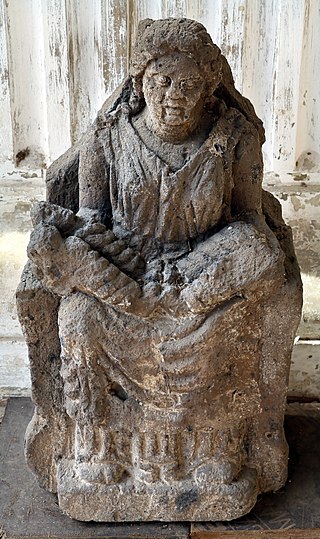
Mater Matuta was an indigenous Latin goddess, whom the Romans eventually made equivalent to the dawn goddess Aurora and the Greek goddess Eos. She was the goddess of female maturation and later also of the dawn. Her cult is attested to in several places in Latium; her most famous temple was located at Satricum.

Etruscan religion comprises a set of stories, beliefs, and religious practices of the Etruscan civilization, heavily influenced by the mythology of ancient Greece, and sharing similarities with concurrent Roman mythology and religion. As the Etruscan civilization was gradually assimilated into the Roman Republic from the 4th century BC, the Etruscan religion and mythology were partially incorporated into ancient Roman culture, following the Roman tendency to absorb some of the local gods and customs of conquered lands. The first attestations of an Etruscan religion can be traced back to the Villanovan culture.

Juno was an ancient Roman goddess, the protector and special counsellor of the state. She was equated to Hera, queen of the gods in Greek mythology and a goddess of love and marriage. A daughter of Saturn and Ops, she was the sister and wife of Jupiter and the mother of Mars, Vulcan, Bellona, Lucina and Juventas. Like Hera, her sacred animal was the peacock. Her Etruscan counterpart was Uni, and she was said to also watch over the women of Rome. As the patron goddess of Rome and the Roman Empire, Juno was called Regina ("Queen") and was a member of the Capitoline Triad, centered on the Capitoline Hill in Rome, and also including Jupiter, and Minerva, goddess of wisdom.

Swaddling is an ancient practice of wrapping infants in blankets or similar cloths so that movement of the limbs is tightly restricted. Swaddling bands were often used to further restrict the infant. Swaddling fell out of favour in the 17th century.

Uni is the ancient goddess of marriage, fertility, family, and women in Etruscan religion and myth, and was the patron goddess of Perugia. She is identified as the Etruscan equivalent of Juno in Roman mythology, and Hera in Greek mythology. As the supreme goddess of the Etruscan pantheon, she is part of the Etruscan trinity, an original precursor to the Capitoline Triad, made up of her husband Tinia, the god of the sky, and daughter Menrva, the goddess of wisdom.

Satricum, an ancient town of Latium vetus, lay on the right bank of the Astura river some 60 kilometres (37 mi) SE of Rome in a low-lying region south of the Alban Hills, at the NW border of the Pontine Marshes. It was directly accessible from Rome via a road running roughly parallel to the Via Appia.

Terracotta figurines are a wide range of small figurines made throughout the time span of Ancient Greece, and one of the main types of Ancient Greek pottery. Early figures are typically religious, modelled by hand, and often found in large numbers at religious sites, left as votive offerings. Psi and phi type figurines are two very early and simple types, dating as far back as 1400 BCE.
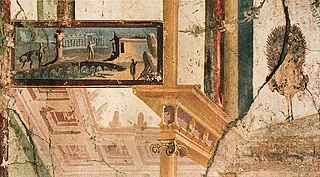
In the modern study of the culture of ancient Greece and Magna Graecia, a pinax is a votive tablet of painted wood, or terracotta, marble or bronze relief that served as a votive object deposited in a sanctuary or as a memorial affixed within a burial chamber. Such pinakes feature in the classical collections of most comprehensive museums.
Agia Eirini or Agia Irini is a village located on Morphou Bay, approximately 10 km north of Morphou. The village is located within Kyrenia District. It is under the de facto control of Northern Cyprus.
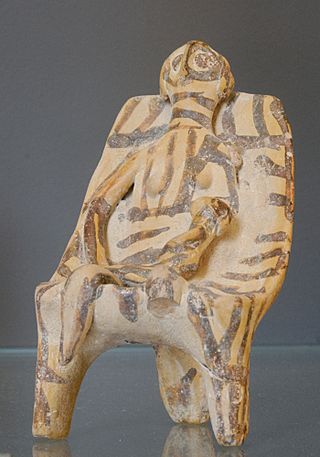
Kourotrophos is the name that was given in ancient Greece to gods and goddesses whose properties included their ability to protect young people. Numerous gods are referred to by the epithet such as Athena, Apollo, Hermes, Hecate, Aphrodite, Artemis, Eileithyia, Demeter, Gaia, Cephissus and Asclepius. They were usually depicted holding an infant in their arms. Deianeria and Ariadne were occasional shown on vases with their children, Hyllus and Staphylos and Oenopion respectively, but there is no evidence that there was a cult around them as kourotrophic figures.
Childbirth in Ghana is often seen as a joyous occasion in Ghanaian society, as children represent wealth, status, and the continuation of a lineage. Pregnant women are often given special privileges and are considered to be beautiful, fragile, and vulnerable to evil spirits. Therefore, women may seek guidance from a religious or spiritual diviner to protect their fetus or to increase their chances of conceiving. For example, the Akan may carry akuaba dolls, a fertility symbol, during pregnancy to ensure that they will birth a healthy and beautiful baby that resembles the doll's exaggerated features.
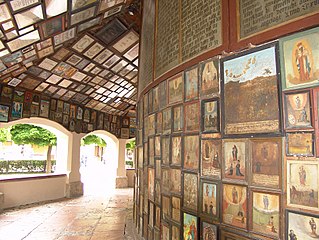
A votive offering or votive deposit is one or more objects displayed or deposited, without the intention of recovery or use, in a sacred place for religious purposes. Such items are a feature of modern and ancient societies and are generally made in order to gain favor with supernatural forces.
Lucus Pisaurensis is a sacred grove or lucus of ancient Pisaureum, modern Pesaro in Italy. It is just outside the coastal comune of Pesaro, between the Colle della Salute and the Collina in Santa Veneranda. It is in the Pesaro e Urbino Province of Marche, a pre-Imperium Romanum region of the Sabines and Latins peoples.
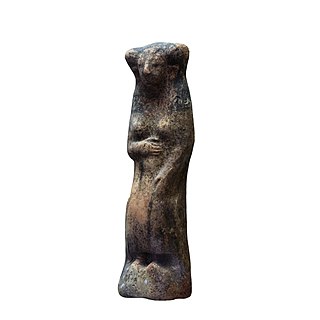
Dea Gravida or Dea Tyria Gravida was either a goddess or representation of mortal women that were associated with procreation and fertility deriving from Phoenician culture and spreading within the Phoenician circle of influence. Although not much is known about the cult surrounding Dea Gravida, votive terracotta statues have been found throughout the Mediterranean, most notably in Phoenicia and Cyprus. The figure differs from kourotrophic figures that hold babies and are not visibly pregnant.

The Sanctuary of Artemis Orthia, an Archaic site devoted in Classical times to Artemis, was one of the most important religious sites in the Greek city-state of Sparta, and continued to be used into the fourth century CE, when all non-Christian worship was banned during the persecution of pagans in the late Roman Empire. The sanctuary was destroyed and rebuilt a few times over many centuries and has today produced many artefacts that allow historians to better understand exactly what went on in the sanctuary during that period of time. This sanctuary held many rituals, that included cult-like behaviour by both young males and females in varying ways and has also since revealed many artefacts due to multiple excavations that have helped to deliver new information on acts and behaviours that have occurred in at the temple in Orthia.
The Samnites were an ancient Italic people who lived in modern south-central Italy, placing them between the Latins to the north and the Greek settlements to the south. Consequently, the Samnites had anthropomorphic deities shared with both Rome and Greece, especially after their conquest of Campania at the end of the fourth century BCE. There is additional evidence that suggests the Samnites also believed in spirits called numina. Numina are believed to have been kinless, animistic spirits that could take human form to walk amongst the living. To the Samnites, having good relations with these spirits was of the utmost importance. To honor these deities, the Samnites would sacrifice either living things or make votive offerings.
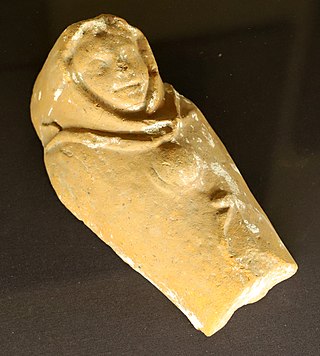
A baby votive is an offering presented to a supernatural power at a shrine and represents an infant or child in the first few years of life. The phenomenon can be found across cultures at various points in history. They are easiest to identify in cultures with a visual tradition that distinguishes babies from older children and adults. They take a variety of forms, such as a swaddled infant or seated baby, and can be two-dimensional or three-dimensional.
{{cite book}}: CS1 maint: location missing publisher (link)